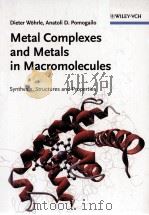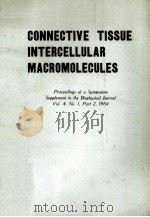《Macromolecules·1》
| 作者 | 编者 |
|---|---|
| 出版 | 未查询到或未知 |
| 参考页数 | 532 |
| 出版时间 | 没有确切时间的资料 目录预览 |
| ISBN号 | 无 — 求助条款 |
| PDF编号 | 811443538(仅供预览,未存储实际文件) |
| 求助格式 | 扫描PDF(若分多册发行,每次仅能受理1册) |

Part Ⅰ.Structure1
Chapter 1.Introduction3
1.1.Micro-and Macromolecular Chemistry3
1.2.The Molecular Concept12
1.3.Historical Development15
1.4.Nomenclature24
1.5.Commercial Classification and Significance28
Literature32
Chapter 2.Constitution37
2.1.The Concept of Structure37
2.2.Atomic Structure and Polymer Chain Bonds38
2.2.1.Isochains39
2.2.2.Heterochains42
2.3.Monomeric Unit Bonding47
2.3.1.Unipolymers47
2.3.2.Copolymers50
2.3.2.1.Composition51
2.3.2.2.Constitutional Heterogeneity52
2.3.2.3.Sequence58
2.3.3.Substituents62
2.3.4.End Groups63
2.4.Bonding in Individual Chains64
2.4.1.Branching64
2.4.2.Irregular Cross-Linked Structures66
2.4.3.Ordered Networks69
Literature72
Chapter 3.Configuration75
3.1.Ideal Structures75
3.1.1.Central Carbon Atom Asymmetry75
3.1.2.Tacticity78
3.1.3.Projections80
3.1.4.Monotactic Polymers81
3.1.5.Ditactic Polymers82
3.2.Real Structures84
3.2.1.J-ads84
3.2.2.Sequence Length86
3.3.Experimental Methods87
3.3.1.X-Ray Crystallography87
3.3.2.Nuclear Magnetic Resonance Spectroscopy87
3.3.3.Infrared Spectroscopy90
3.3.4.Other Methods90
Literature91
Chapter 4.Conformation93
4.1.Conformation of Single Molecules93
4.1.1.The Concept of Conformation93
4.1.2.Conformational Types97
4.1.3.Conformational Analysis99
4.1.4.Constitutional Influence100
4.2.Conformation in the Crystal102
4.3.Microconformation in Solution108
4.3.1.Low-Molecular-Weight Compounds108
4.3.2.Macromolecular Compounds110
4.4.Ideal Coil Molecules in Solution112
4.4.1.Phenomena112
4.4.2.Chain End-to-End Distance and Radii of Gyration114
4.4.2.1.The Random-Flight Model114
4.4.2.2.Chains with Constant Valence Angle115
4.4.2.3.Constant Valence Angle Chains with Hindered Rotation115
4.4.2.4.Radius of Gyration116
4.4.2.5.The Shape of Unperturbed Coils117
4.4.3.Steric Hindrance Parameter and Constitution117
4.4.4.The Characteristic Ratio119
4.4.5.Statistical Chain Element120
4.4.6.Wormlike Chain121
4.5.Excluded Volume123
4.5.1.Rigid Particles123
4.5.2.Unbranched Macromolecules124
4.5.2.1.Basic Principles124
4.5.2.2.Cluster Integrals126
4.5.2.3.Molecular-Weight Dependence of Coil Dimensions127
4.5.2.4.Concentration and Temperature Dependence of Coil Dimensions130
4.5.3.Branched Macromolecules131
4.6.Compact Molecules131
4.6.1.Helices131
4.6.2.Ellipsoids and Spheres132
4.7.Optical Activity133
4.7.1.Basic Principles133
4.7.2.Structural Effects135
4.7.2.1.General Considerations135
4.7.2.2.Poly(α-olefins)137
4.7.2.3.Poly(α-amino acids)140
4.7.2.4.Proteins141
4.8.Conformational Transitions142
4.8.1.Thermodynamics142
4.8.2.Kinetics145
A4.Appendix to Chapter 4146
A4.1.Calculation of the Chain End-to-End Distance146
A4.2.Relationship between the Radius of Gyration and the Chain End-to-End Distance for the Segment Model147
A4.3.Calculation of the Chain End-to-End Distance for Valence Angle Chains149
A4.4.Distribution of Chain End-to-End Distances151
Literature152
Chapter 5.Supermolecular Structures155
5.1.Phenomena155
5.2.Crystallinity Determination158
5.2.1.X-Ray Crystallography158
5.2.2.Density Measurements163
5.2.3.Calorimetry165
5.2.4.Infrared Spectroscopy165
5.2.5.Indirect Methods166
5.3.Crystal Structure167
5.3.1.Molecular Crystals167
5.3.2.Elementary and Unit Cells167
5.3.3.Polymorphism171
5.3.4.Isomorphism172
5.3.5.Lattice Defects172
5.4.Morphology of Crystalline Polymers174
5.4.1.Fringed Micelles174
5.4.2.Polymer Single Crystals176
5.4.3.Spherulites182
5.4.4.Dendrites and Epitaxial Growth184
5.5.The Amorphous State186
5.5.1.Free Volumes186
5.5.2.Morphology188
5.5.3.Polymer Alloys190
5.5.4.Block Copolymers190
5.6.Orientation191
5.6.1.Definition191
5.6.2.X-Ray Diffraction193
5.6.3.Optical Birefringence194
5.6.4.Infrared Dichroism195
5.6.5.Polarized Fluorescence195
5.6.6.Sound Propagation196
Literature197
Part Ⅱ.Solution Properties202
Chapter 6.Solution Thermodynamics203
6.1.Basic Principles203
6.2.Solubility Parameter205
6.2.1.Basic Principles205
6.2.2.Experimental Determination207
6.2.3.Applications209
6.3.Statistical Thermodynamics211
6.3.1.Entropy of Mixing211
6.3.2.Enthalpy of Mixing212
6.3.3.Gibbs Energy of Mixing for Nonelectrolytes213
6.3.4.Gibbs Energy of Mixing for Polyelectrolytes215
6.3.5.Chemical Potential of Concentrated Solutions215
6.3.6.Chemical Potential of Dilute Solutions217
6.4.Virial Coefficients218
6.4.1.Definitions218
6.4.2.Excluded Volume219
6.5.Association222
6.5.1.Basic Principles222
6.5.2.Open Association224
6.5.3.Closed Association227
6.5.4.Concentrated Solutions and Melts229
6.6.Rhase Separation230
6.6.1.Basic Principles230
6.6.2.Upper and Lower Critical Solution Temperatures231
6.6.3.Quasibinary Systems233
6.6.4.Fractionation and Microencapsulation237
6.6.5.Determination of Theta States238
6.6.6.Incompatibility241
6.6.7.Swelling242
6.6.8.Crystalline Polymers244
Literature246
Chapter 7.Transport Phenomena249
7.1.Effective Quantities249
7.2.Diffusion in Dilute Solution250
7.2.1.Basic Principles250
7.2.2.Experimental Methods253
7.2.3.Molecular Quantities255
7.3.Permeation through Solids256
7.3.1.Basic Principles256
7.3.2.Experimental Methods257
7.3.3.Constitutional Influence258
7.4.Rotational Diffusion and Streaming Birefringence260
7.5.Electrophoresis261
7.6.Viscosity263
7.6.1.Concepts263
7.6.2.Methods266
7.6.3.Flow Curves270
7.6.4.Viscosities of Melts271
7.6.5.Viscosity of Concentrated Solutions275
Literature275
Chapter 8.Molecular Weights and Molecular-Weight Distributions277
8.1.Introduction277
8.2.Statistical Weights278
8.3.Molecular-Weight Distributions280
8.3.1.Representation of the Distribution Functions280
8.3.2.Types of Distribution Functions282
8.3.2.1.Gaussian Distribution282
8.3.2.2.Logarithmic Normal Distribution284
8.3.2.3.Poisson Distribution286
8.3.2.4.Schulz-Flory Distribution287
8.3.2.5.Tung Distribution288
8.4.Moments288
8.5.Averages289
8.5.1.General Relationships289
8.5.2.Simple One-Moment Averages290
8.5.3.One-Moment Exponent Averages291
8.5.4.Multimorment Averages291
8.5.5.Polydispersity Parameters294
Literature295
Chapter 9.Determination of Molecular Weight and Molecular-Weight Distribution297
9.1.Introduction and Survey297
9.2.Membrane Osmometry299
9.2.1.Semipermeable Membranes299
9.2.2.Experimental Methods301
9.2.3.Nonsemipermeable or Leaky Membranes304
9.3.Ebulliometry and Cryoscopy307
9.4.Vapor-Phase Osmometry308
9.5.Light Scattering309
9.5.1.Basic Principles309
9.5.2.Small Particles310
9.5.3.Copolymers314
9.5.4.Concentration Dependence317
9.5.5.Large Particles320
9.5.6.Experimental Procedure324
9.6.Small-Angle X-Ray and Neutron Scattering325
9.7.Ultracentrifugation326
9.7.1.Phenomena and Methods326
9.7.2.Basic Equations329
9.7.3.Sedimentation Velocity330
9.7.4.Equilibrium Sedimentation333
9.7.5.Sedimentation Equilibrium in a Density Gradient334
9.7.6.Preparative Ultracentrifugation337
9.8.Chromatography338
9.8.1.Elution Chromatography338
9.8.2.Gel-Permeation Chromatography338
9.8.3.Adsorption Chromatography342
9.9.Viscometry343
9.9.1.Basic Principles343
9.9.2.Experimental Methods345
9.9.3.Concentration Dependence for Nonelectrolytes350
9.9.4.Concentration Dependence for Polyelectrolytes352
9.9.5.The Staudinger Index and the Molecular Weight of Rigid Molecules354
9.9.6.The Molecular Weight and Staudinger Index of Coil-like Molecules357
9.9.7.Calibration of the Viscosity-Molecular Weight Relationship362
9.9.8.Influence of the Chemical Structure on the Staudinger Index364
9.9.9.Temperature Dependence of the Staudinger Indices366
Literature367
Part Ⅲ.Solid-State Properties372
Chapter 10.Thermal Transitions373
10.1.Basic Principles373
10.1.1.Phenomena373
10.1.2.Thermodynamics374
10.2.Special Parameters and Methods378
10.2.1.Expansion378
10.2.2.Heat Capacity380
10.2.3.Differential Thermal Analysis381
10.2.4.Nuclear Magnetic Resonance383
10.2.5.Dynamic Methods384
10.2.6.Industrial Testing Methods384
10.3.Crystallization386
10.3.1.Morphology386
10.3.2.Formation of Nuclei387
10.3.3.Crystal Growth or Crystallization390
10.3.4.The Influence of Additives395
10.3.5.Recrystallization395
10.4.Melting396
10.4.1.Melt Processes396
10.4.2.Melting Temperature and Molecular Weight399
10.4.3.Melting Point and Constitution400
10.4.4.Melting Point of Copolymers405
10.5.Glass Transitions405
10.5.1.Phenomena405
10.5.2.Static and Dynamic Glass-Transition Temperatures406
10.5.3.Glass-Transition Temperature and Constirution408
10.5.4.Glass-Transition Temperature and Configuration410
10.5.5.Glass-Transition Temperature ofCopolymers410
10.5.6.Plasticizers412
10.6.Other Transitions414
10.7.Thermal Conductivity416
Literature417
Chapter 11.Mechanical Properties421
11.1.Phenomena421
11.2.Energy-Elasticity424
11.2.1.Basic Parameters424
11.2.2.Structural Influences425
11.3.Entropy-Elasticity427
11.3.1.Phenomena427
11.3.2.Phenomenological Thermodynamics431
11.3.3.Statistical Thermodynamics433
11.3.4.Elastoosmometry437
11.4.Viscoelasticity438
11.4.1.Basic Principles438
11.4.2.Relaxation Processes440
11.4.3.Retardation Processes441
11.4.4.Combined Processes442
11.4.5.Dynamic Loading443
11.5.Deformation Processes444
11.5.1.Tensile Tests444
11.5.2.Necking447
11.5.3.Hardness450
11.6.Fracture451
11.6.1.Concepts and Methods451
11.6.2.Theory of Brittle Fracture452
11.6.3.Impact Strength455
11.6.4.Reinforcement457
11.6.5.Plasticization458
11.6.6.Stress Cracking459
11.6.7.Durability459
Literature461
Chapter 12.Compounding and Processing of Plastics463
12.1.Compounding463
12.1.1.General463
12.1.2.Fillers464
12.1.3.Dyes and Pigments466
12.1.4.Piasticizers468
12.1.5.Release Agents,Lubricants,Stabilizers,and Antistatics468
12.2.Processing of Thermoplasts,Thermosets,and Elastomers469
12.2.1.Classification469
12.2.2.Processing via the Viscous State470
12.2.3.Processing via the Elastoviscous State472
12.2.4.Processing via the Elastoplastic State475
12.2.5.Processing via the Viscoelastic State477
12.2.6.Processing via the Solid State478
12.3.Fiber Processing479
12.3.1.Introduction479
12.3.2.Fiber Formation481
12.3.3.Spinning Techniques482
12.3.4.Spin Processes484
12.3.5.Drawing486
12.3.6.Fiber Properties487
12.4.Finishing(Surface Treatment)491
12.4.1.Metallizing491
12.4.2.Glass Coating491
Literature492
Chapter 13.Interfacial Phenomena495
13.1.Spreading495
13.2.Interfacial Tensions496
13.2.1.Surface Tension of Liquid Polymers496
13.2.2.Interfacial Tension of Solid Polymers498
13.2.2.1.Basic Principles498
13.2.2.2.Critical Surface Tension499
13.3.Adsorption of Polymers501
13.4.Adhesives and Glues503
13.4.1.Adhesion503
13.4.2.Gluing505
Literature507
Chapter 14.Electrical Properties509
14.1.Dielectric Properties509
14.1.1.Polarizability510
14.1.2.Behavior in an Alternating Electric Field510
14.1.3.Dielectric Field Strength512
14.1.4.Tracking513
14.1.5.Electrostatic Charging513
14.1.6.Electrets515
14.2.Electronic Conductivity516
14.2.1.Influence of Chemical Structure516
14.2.2.Measuring Techniques520
Literature521
Chapter 15.Optical Properties523
15.1.Light Refraction523
15.2.Light Interference and Color525
15.2.1.Basic Principles525
15.2.2.Iridescent Colors526
15.3.Light Transmission and Reflection527
15.3.1.Total Reflection527
15.3.2.Transparency528
15.3.3.Gloss529
15.4.Light Scattering530
15.4.1.Phenomena530
15.4.2.Opacity531
Literature532
《Macromolecules·1》由于是年代较久的资料都绝版了,几乎不可能购买到实物。如果大家为了学习确实需要,可向博主求助其电子版PDF文件。对合法合规的求助,我会当即受理并将下载地址发送给你。
高度相关资料
-

- DIFFRACTION METHODS FOR BIOLOGICAL MACROMOLECULES
- 1985 ACADEMIC PRESS
-

- PARTITION OF CELL PARTICLES AND MACROMOLECULES
- JOHN WILEY-SONS NEW YORK
-

- STATISTICAL PHYSICS OF MACROMOLECULES
- 1994 ATP PRESS
-

- ELECTROPHORESIS IN THE SEPARATION OF BIOLOGICAL MACROMOLECULES
- 1980年 JOHN WILEY & SONS
-
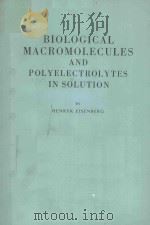
- BIOLOGICAL MACROMOLECULES AND POLYELECTROLYTES IN SOLUTION
- 1976 CLARNDON PRESS
-

- STRUCTURAL STUDIES OF MACROMOLECULES BY SPECTROSCOPIC METHODS
- 1976 A WILEY INTERSCIENCE PUBLICATION
-

- Crystallization of biological macromolecules
- 1999 Cold Spring Harbor Laboratory Press
-
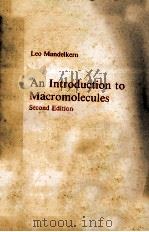
- AN INTRODUCTION TO MACROMOLECULES SECOND EDITION
- 1972 SPRINGER-VERLAG NEW YORK INC
-

- MACROMOLECULES IN SOLUTION
- 1965 INTERSCIENCE PUBLISHERS
-
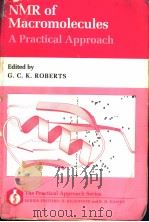
- NMR OF MACROMOLECULES A PRACTICAL APPROACH
- 1993 IRL PRESS
提示:百度云已更名为百度网盘(百度盘),天翼云盘、微盘下载地址……暂未提供。➥ PDF文字可复制化或转WORD

